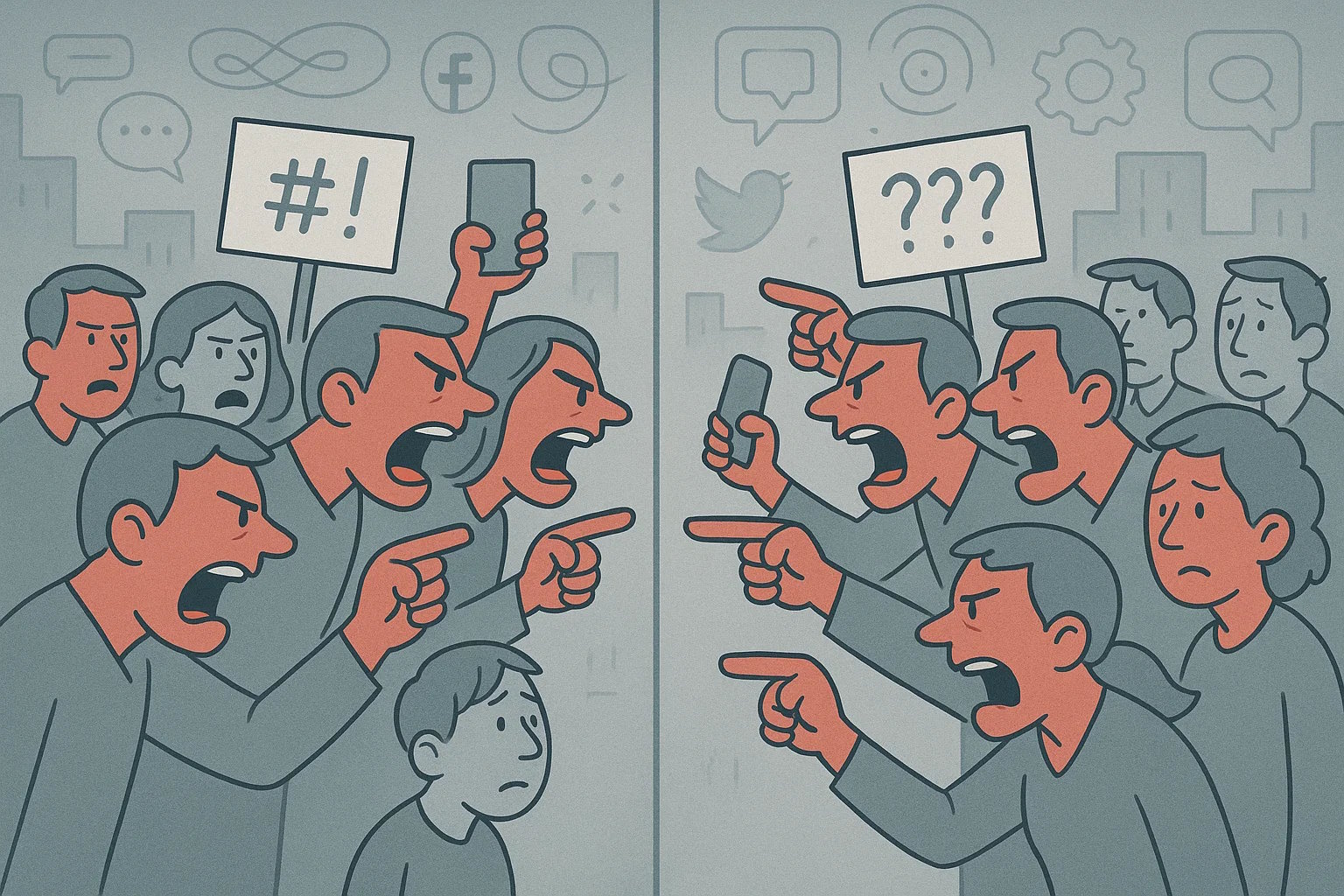Functional Tribalism vs. Toxic Tribalism: Reclaiming the Instinct
Last time, we walked through A Long Drift from Our Roots: How Modernity Destroyed the Tribe. We traced the historical arc of disconnection, from the settling of the Agricultural Revolution to the digital atomization of today. We unpacked the biological and psychological cost of our Stone-Age brains living in a digital world; an evolutionary misfire that leaves us overwhelmed and isolated, battling a “new suffering” where safety breeds weakness and ease creates a crisis of under-stimulation. We ended by affirming that our longing for Tribe isn’t just a form of nostalgia; it’s a biological imperative, a primal scream from our very DNA for the belonging and shared purpose we were designed for.
But here’s where we need to be profoundly careful. The human longing for a tribe, this deep, ancient craving for belonging, when misdirected or corrupted, can become something truly dangerous. It can manifest as a desperate search for identity that leads us into division, exclusion, and even hatred. We’ve seen this play out throughout history, and it’s rampaging through our modern world with alarming ferocity.
So, before we talk about building functional tribes, we absolutely must untangle this critical distinction. We must understand the difference between the kind of tribalism that builds and the kind that burns.
Defining the Two Forms: Enemy-Focused (Toxic) vs. Purpose-Focused (Functional)
Let’s be clear. When we talk about “tribe” in the context of reclaiming our human wiring, we are talking about a specific, life-affirming kind of connection. This is Functional Tribalism. It’s the innate human drive for belonging channeled into shared struggle, mutual support, and co-creation towards a common, elevating purpose. It’s about building something with people, for building something bigger than yourself. Its energy is inclusive, its gaze is forward, and its purpose is growth.
Then there’s the other kind, the one that’s far too rampant right now. This is Toxic Tribalism. It’s also fueled by an innate human drive for belonging, but it’s warped and deeply-flawed. Instead of building towards a purpose, it builds against an enemy. Its energy is inherently divisive, its gaze is backwards (or perpetually locked on an ‘other’ to demonize), and its purpose is often self-preservation through exclusion. It thrives on fear, outrage, and the simplistic narrative of “us vs. them.”
It doesn’t ask, “What can we create together?” It demands, “Who are we united against?”
The subtle but crucial difference lies in the source of the bonding. Functional tribalism bonds around a shared vision or challenge. Toxic tribalism bonds around a shared enemy or grievance. One builds bridges, however small, between diverse individuals for a common good. The other builds walls, however tall, between groups, for the sake of perceived purity or power.
Why Modern Identity Politics and Online Outrage Are Forms of Toxic Tribalism
Look around. We see toxic tribalism everywhere, masquerading as righteous anger or screechy calls for justice. Modern identity politics, while often rooted in legitimate grievances, can easily slide into this dangerous territory. When our primary identity becomes defined only by our group affiliation, and our group’s existence is validated only by the opposition of another, we’ve slipped. The nuance is lost. The individual human experience becomes subservient to the collective grievance, and empathy for anyone outside the perceived boundary withers.
Online outrage is the perfect petri dish for toxic tribalism. It’s fast, it’s anonymous, and it thrives on the instantaneous rush of moral superiority. Algorithms, as we discussed, are designed to feed us more of what confirms our biases, more of what ignites our anger. Why? Because anger drives attention, and your attention sells advertising. It’s basically attention-farming, and we’re willingly exchanging our precious time to line someone else’s pockets.
The mechanism is pretty simple. They serve up enemies on a silver platter. Someone says something insensitive, or politically incorrect, or just plain stupid, and suddenly, the “tribe” mobilizes. But it’s not a tribe forming around a constructive purpose; it’s a mob coalescing around a target. The bonding comes from shared condemnation and from the collective thrill of tearing someone down.
This, of course, isn’t isolated to just one political leaning. Across the spectrum, toxic tribes have emerged like ideological black holes. There’s the Victimhood Cult, where pain becomes currency and healing is treated as betrayal. The Rage-Fueled Ideologue, addicted to purity tests and allergic to nuance. The Hustle Cult, where burnout is mistaken for valor and human worth is tied to productivity. The Sexless Self-Help Loop, all smiles and sunshine while shadow festers underneath. The Red Pill and Radical Feminist Burnouts, forging identity through gendered resentment, mistaking enemies for intimacy. And the Algorithmic Identity Tribe, whose members don’t even know they’ve joined, shaped invisibly by curated feeds until they forget who they actually are.
These ideological cesspools aren’t about solving problems so much as they’re about performing solidarity. It drains our energy, locks us into echo chambers, and systematically destroys our capacity for productive dialogue and genuine understanding.
We become addicted to the fight, the drama, and the validation of our shared hatred. The emotional stakes are high, but the real-world consequence is often just deeper division. It’s a self-perpetuating cycle of resentment, cleverly designed to keep us inflamed and isolated from anyone who doesn’t perfectly mirror our convictions. It provides the feeling of belonging and the rush of shared purpose, but that feeling of belonging is just a hollow, destructive facsimile, leaving a trail of broken relationships and a fractured society.
We become soldiers in a war of attention and attrition, battling phantoms on screens while the real work of human connection languishes.
How Functional Tribalism Channels Our Innate Drive for Belonging into Shared Struggle and Co-creation
So, if toxic tribalism is a misfire of our ancient wiring, how do we reclaim the true power of the tribe? We do it by consciously, deliberately, channeling our innate drive for belonging towards something constructive. This is the heart of Functional Tribalism: it channels our primal need for connection not into tearing down, but into building up.
Imagine a group of people united not by who they hate, but by what they love. Not by a common enemy, but by a common dream. This isn’t some hippie abstract idea. It’s a deeply practical, achievable roadmap.
At the most basic level, this project, this experiment, is about finding people who are willing to roll up their sleeves and engage in shared struggle. Because genuine struggle, faced together, is the crucible of true connection. It’s in the moments of challenge, when we have to lean on each other, when we see each other’s vulnerabilities and strengths laid bare, that superficialities fall away and real bonds are forged.
Functional tribalism creates a container for co-creation. It’s the group that gathers to build a community garden, to start a new business, to support each other through a difficult life transition, to explore challenging intellectual concepts, or simply to commit to showing up, week after week, to share their real lives.
The “enemy” isn’t other people; it’s often the external challenge, the internal resistance, the collective problem that needs solving. Our energy is focused outward, on making something, doing something, or being something together. This kind of tribe doesn’t demand uniformity of thought, but rather a unity of purpose. It thrives on diversity of perspective, because it understands that a richer fabric is woven from different threads.
This kind of tribalism demands courage. It asks us to step out of our comfortable echo chambers and engage with the messy reality of other human beings. It asks us to be vulnerable, to trust, to contribute, and to hold others accountable with compassion.
It’s not always easy, but it’s real. It provides the deep sense of purpose, the psychological safety, and the authentic belonging that our Stone-Age brains are truly craving. It’s about reclaiming our inherent human design for connection, transforming it from a source of division into a source of profound strength, meaning, and co-creation. It’s about building a fire that warms and illuminates, rather than one that consumes.
So, we’ve documented the source of our pain. We’ve established this lack of connection accounts for about 70% of our most pressing problems. We’ve traced our long, painful drift from roots that once held us. And we’ve drawn a clear, unyielding line between the kind of tribalism that destroys and the kind that actually builds.
But knowing what we need, and knowing what to avoid, isn’t the same as knowing how to build it. How do we move from this intellectual understanding to the messy, beautiful reality of crafting those life-affirming connections?
This experiment outlines a real, authentic, tangible process. It’s a ladder, if you will, with distinct rungs, each demanding a different level of vulnerability, commitment, and shared purpose.
In our next conversation, we’re going to lay out this exact blueprint. We’ll introduce The 5 Depths of Tribe: A Map of Belonging. We’ll start at the ground level, with the Activity Group. where stakes are low and the primary focus is recreation. Then, we’ll ascend to the Community Circle, where a shared ethos begins to emerge with light accountability. From there, we’ll explore the deep trust forged in the Mission Tribe, born from shared struggle. The path continues to the profound, vetted loyalty of Blood Trust Brotherhood/Sisterhood, where the stakes become truly high. And finally, we’ll reach the summit: the Life-Bound Circle, a realm of profound interdependence and shared legacy. This is the practical roadmap for building the fire your nervous system craves..
~Jason
P.S. – If this idea resonates with you, consider joining our Facebook Group and our Subreddit.
To navigate through the posts in this series, go here:


Leave a Reply